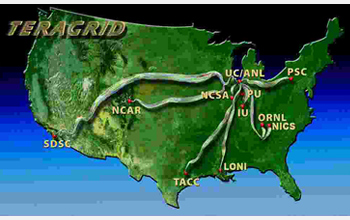

Press Release 08-108
July 15 Deadline to Apply for High-Performance Computational Time on Teragrid

June 26, 2008
Scientists, engineers and other U.S. researchers may apply by July 15 (12:00 midnight local times) for allocations of high-performance computer time, storage and systems resources available through the TeraGrid, a partnership of 11 nationwide sites, sponsored by the Office of Cyberinfrastructure of the National Science Foundation (NSF). For this allocation period, Oct. 1, 2008 through Sept. 30, 2009, researchers may request medium allocations, or large allocations greater than 500,000 service units (SU) of computer time. Each SU represents one processor-hour a researcher can use on one of the TeraGrid's powerful computer systems. During the most recent round of requests in June, 109 proposals were submitted, resulting in allocations totaling more than 48 million SUs and 109 terabytes (TB) of data storage. A Teragrid teleconference will be held to provide step-by-step instructions and answers on how to write and submit a successful proposal from 2:00-3:30 p.m. (Central Time), Thurs., June 26. Call 1-866-740-1260 and enter Access Code 8229741. To view the presentation online during the talk, visit http://www.readytalk.com/ during the call and enter the same access code in the "Participant Login box." Enter your name and institution when requested. With the deployment of the computing system called "Kraken" at the National Institute for Computational Sciences (NICS), along with the additions of Purdue University's Dell 1950 Cluster called "Steele" and Indiana University's IBM HS21 Bladeservers for Gateways called "Quarry," the total computational capacity of the TeraGrid soon will exceed one petaflop. A petaflop represents a computer's ability to do one quadrillion floating point operations per second. The full list of 26 TeraGrid computing resources is at: http://www.teragrid.org/userinfo/hardware/resources.php. TeraGrid also is making available large amounts of allocated tape and disk storage, as well as servers dedicated to the delivery of data resources via the web. These resources, available for use by individual researchers, research groups, or virtual organizations, include: - Archival storage under the control of High Performance Storage System, up to 100 TB of storage per allocation, for persistent, long-term storage, from Indiana University (IU) and the San Diego Supercomputer Center.
- Dedicated disk space to support databases and data collections, from several sites.
- Dedicated computational resources in support of Science Gateways or data resources (web services for computation and database queries) from NCSA and IU.
- Large shared memory machines at the National Center for Supercomputing Applications (NCSA) at the University of Illinois and the Pittsburgh Supercomputing Center.
Researchers can also apply for other resources, such as animation rendering services from IU and Purdue University (the TeraDRE resource). A detailed list of data-centric and research- and education- oriented TeraGrid resources available for allocation is described at http://www.teragrid.org/userinfo/data/index.php. Submit your requests through POPS (Partnerships Online Proposal System) at https://pops-submit.teragrid.org. Applications are subject to peer review, similar to other major projects funded by the NSF. However, TeraGrid does not re-review the scientific merit of researchers with federally funded research; the existence of federal funding is taken to confirm its scientific merit. For researchers who already are funded, projects are evaluated primarily on the appropriateness of the proposal for the cyberinfrastructure resources requested. Proposals for allocations are reviewed four times a year, with proposals due in January, April, July and October for awards beginning in April, July, October and January, respectively. For additional information, see the allocations section of the TeraGrid User Portal at http://portal.teragrid.org/ or the TeraGrid Web site at http://www.teragrid.org/. For further help with the allocations process, send an e-mail to help@teragrid.org. For people new to TeraGrid, there is a "Getting Started on TeraGrid" guide available on the TeraGrid web site, http://www.teragrid.org/. In addition, a range of live and on-line training events and resources are available to the community, and accessible via the TeraGrid Web site and the TeraGrid User Portal. About TeraGrid The TeraGrid, sponsored by the NSF Office of Cyberinfrastructure, is a partnership of people, resources and services that enables discovery in U.S. science and engineering. Through coordinated policy, grid software, and high-performance network connections, the TeraGrid integrates a distributed set of high-capability computational, data-management and visualization resources to make research more productive. With Science Gateway collaborations and education programs, the TeraGrid also connects and broadens scientific communities. -NSF-

Media Contacts
Lisa-Joy Zgorski, NSF (703) 292-8311 lisajoy@nsf.gov
Program Contacts
Stephen Meacham, NSF (703) 292-8970 smeacham@nsf.gov
Principal Investigators
Scott Lathrop, TeraGrid Director of Education, Outreach and Training (217) 714-2517 lathrop@mcs.anl.gov
Related Websites
Teragrid website: http://www.teragrid.org
Allocations section of the TeraGrid user portal: http://portal.teragrid.org

The National Science Foundation (NSF) is an independent federal agency that supports fundamental research and education across all fields of science and engineering, with an annual budget of $6.06 billion. NSF funds reach all 50 states through grants to over 1,900 universities and institutions. Each year, NSF receives about 45,000 competitive requests for funding, and makes over 11,500 new funding awards. NSF also awards over $400 million in professional and service contracts yearly.
 Get News Updates by Email Get News Updates by Email
Useful NSF Web Sites:
NSF Home Page: http://www.nsf.gov
NSF News: http://www.nsf.gov/news/
For the News Media: http://www.nsf.gov/news/newsroom.jsp
Science and Engineering Statistics: http://www.nsf.gov/statistics/
Awards Searches: http://www.nsf.gov/awardsearch/
|


